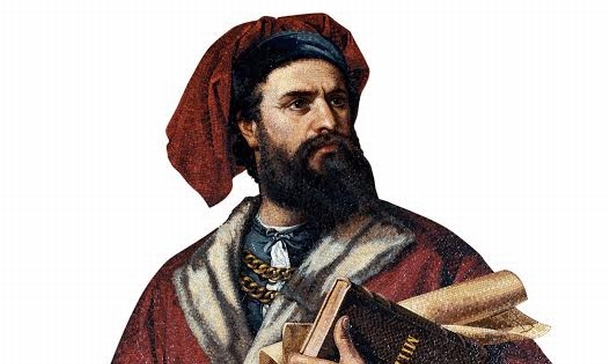
Marco Polo was an Italian merchant, explorer, and writer born in the Republic of Venice in 1254. In 1269 he traveled with his father Niccolo and uncle Maffeo to China on a series of adventures. They returned wealthy men in 1295 only to find Venice in a state of war with the Republic of Genoa. Marco outfitted and armed a galley to join the war against Genoa and was captured during a skirmish sometime between 1296-98. The Travels of Marco Polo is the English title of a book dictated by Polo to romance writer Rustichello da Pisa while the two of them were in a Genoan prison between 1298–99. The book is a travelogue of Polo’s journeys to China, particularly the court of Kublai Khan at Dadu (Beijing) as well as other Asian cities and countries. Critical historical assessments of Polo’s book reveal very poor textual transmission (some extant manuscripts vary in length by as much as 50%), and therefore render it highly unreliable as an analytical historical text. But the same academic criticism notes that Polo was an observant albeit “imaginative” travel author. In Book 1, Chapter 13 of The Travels of Marco Polo, Polo writes that he was shown the three tombs of the three Magi that visited the Christ child in Bethlehem while he was in the city of Saba, Persia.
“In Persia is the city of Saba, from which the Three Magi set out when they went to worship Jesus Christ; and in this city they are buried, in three very large and beautiful monuments, side by side. And above them there is a square building, carefully kept. The bodies are still entire, with the hair and beard remaining.”
[Marco Polo, The Travels of Marco Polo, Rustichello da Pisa. Book 1, Chapter 13]
The tale of the “three wise men” can readily be traced as a European tradition, and the likelihood that a Persian parallel ever existed in less than zero. What is provocative however is that we may be able to glean one fact from Polo’s fable. The Persian city of Saba is the medieval equivalent of the modern city of Saveh, in Markazi Province, Iran, approximately 60 miles south of Tehran. Polo visited Saba some 1300 years after the Magi visited Christ. Saba/Saveh was known as Saavakineh during the Parthian era, and was a main hub on the Silk Road, a network of trade routes that started in the 2nd century BC to transport people, trade goods, and armies between the Far East, Central Asia, Mesopotamia, the Levant, and eventually Asia Minor and Europe. From this and other sources I am convinced that the Magi’s entourage traveled via the Silk Road from their point of origin in Mesopotamia (likely Ctesiphon) northwest to the city of Rezeph (Isaiah 37:12), the equivalent of modern Resafa, Syria, where they would have “turned left” to intersect the King’s Highway, and head toward Damascus, Caesarea, and Jerusalem.
If you enjoyed this article, please consider financially supporting this project via Patreon.
Please check back for more articles from God Save the King.